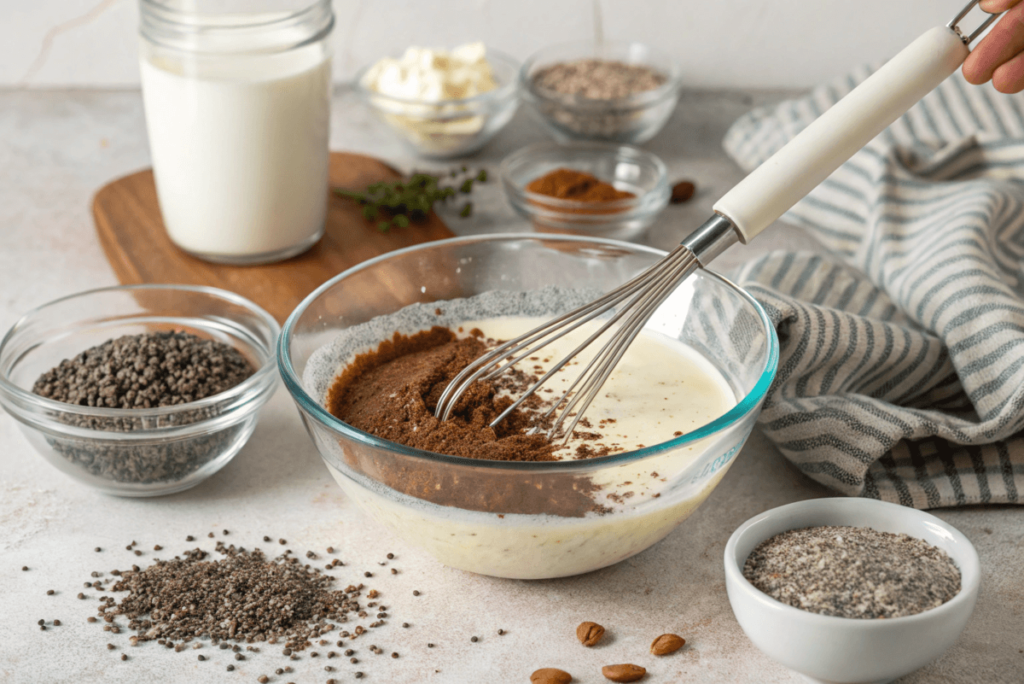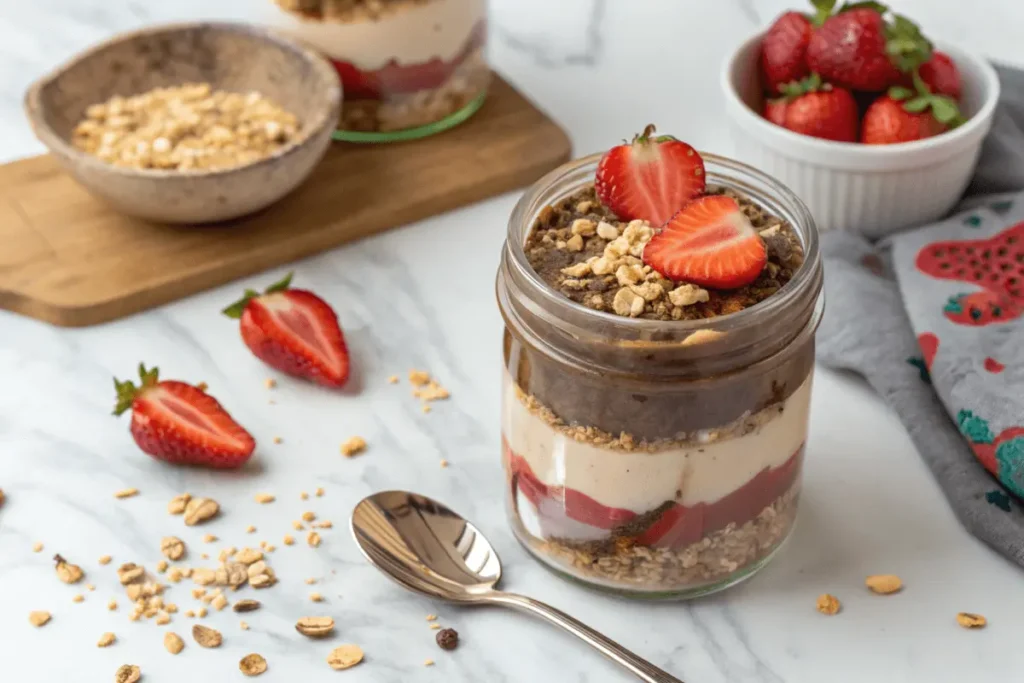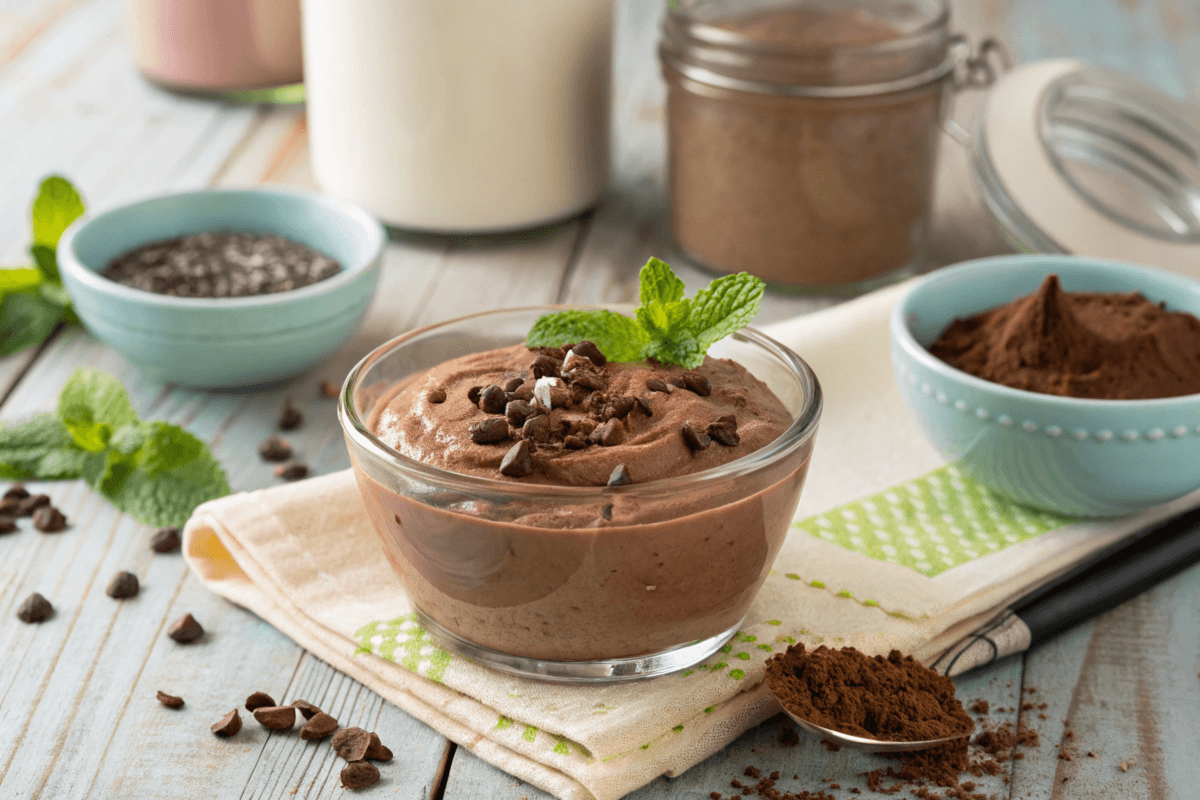Protein pudding has become a popular choice for those seeking a snack or dessert that balances health and indulgence. This creamy, high-protein treat is adored by fitness enthusiasts, dieters, and dessert lovers alike. Have you ever wondered about its ingredients or how it’s made? In this article, we’ll dive into its key components, preparation methods, nutritional benefits, and flavorful variations. By the end, you’ll discover how to make it at home and how to select the best ready-made options. Let’s dive into the world of this versatile and satisfying dessert!
Introduction to Protein Pudding
What is Protein Pudding?
Protein pudding is a creamy, nutrient-rich dessert or snack designed to combine flavor with health benefits. Unlike regular puddings that prioritize taste over nutrition, this version offers a more balanced option for individuals focusing on wellness or fitness goals. It’s a guilt-free indulgence, perfect for those who want to maintain their dietary habits while still enjoying a delicious treat. By incorporating high-quality protein, it becomes both a satisfying dessert and a practical way to meet daily nutritional needs.
A Brief History of Protein-Enriched Foods
The concept of protein-enhanced foods isn’t new. Athletes and bodybuilders have long sought convenient, tasty ways to consume protein. From protein shakes in the 1960s to today’s trendy protein bars and snacks, protein pudding is simply the next evolution. Its rise in popularity mirrors the growing demand for functional foods—edibles that deliver nutritional benefits alongside flavor.
Why Protein Pudding is Popular
Why the hype? Well, protein pudding isn’t just another health fad. It’s versatile, customizable, and perfect for various dietary needs, whether you’re trying to shed pounds, build muscle, or maintain energy levels throughout the day. Fitness buffs love its high protein content, while dessert lovers adore its creamy texture and indulgent taste. Best of all, you can tailor it to suit specific goals, such as low-carb or vegan lifestyles.
Key Ingredients in Protein Pudding
Core Ingredients: Protein Powder and Milk Alternatives
The foundation of protein pudding lies in its core ingredients: protein powder and a liquid base. Typically, a high-quality protein powder such as whey, casein, or plant-based options like pea or soy protein is used. These powders are packed with essential amino acids that support muscle recovery and overall health.
The liquid base can vary depending on dietary preferences. While dairy milk works for many, plant-based alternatives like almond milk, oat milk, or coconut milk are excellent substitutes. These options not only cater to lactose-intolerant individuals but also add unique flavors and textures to the pudding.
Additives for Flavor and Texture
To enhance flavor and create the signature creamy texture, thickeners like Greek yogurt, chia seeds, or xanthan gum are often included. These ingredients help achieve that luscious consistency while keeping the calorie count in check. For an extra indulgent touch, unsweetened cocoa powder, vanilla extract, or matcha can be mixed in.
Common Sweeteners and Binders Used
Sweetness is key to making protein pudding irresistible. Low-calorie sweeteners such as stevia, monk fruit, or erythritol are popular choices. They provide the right amount of sweetness without spiking blood sugar levels. Additionally, ingredients like gelatin or agar-agar can act as binders, ensuring the pudding sets properly.
By combining these versatile ingredients, you can craft a pudding tailored to your taste and dietary needs. Whether you’re after a decadent chocolate version or a refreshing fruit-flavored twist, the possibilities are endless.
How to Make Protein Pudding
Basic Recipe for Homemade Protein Pudding
Making protein pudding at home is surprisingly simple. Start by mixing one scoop of protein powder with half a cup of your preferred milk or milk alternative. Whisk until smooth. Add a tablespoon of Greek yogurt or chia seeds to thicken the mixture. Refrigerate for 1-2 hours, and voilà—your creamy treat is ready to enjoy!

Alternative Ingredients for Different Diets
Want to make it vegan? Swap whey protein for a plant-based alternative and use coconut or almond milk. For a keto-friendly option, opt for unsweetened almond milk and add a dash of heavy cream for extra richness. These tweaks make it easy to customize the recipe for various dietary needs.
Tips for Perfect Texture and Flavor
Getting the texture just right can be tricky. If your pudding turns out too runny, try adding more chia seeds or a small pinch of xanthan gum. For extra flavor, stir in cocoa powder, a splash of vanilla, or even a handful of fresh fruit. Remember, refrigerating the mixture for an adequate amount of time allows the ingredients to blend harmoniously, enhancing both flavor and consistency.
For more creative ideas and detailed steps, check out this Protein Pudding Recipe on Lively Cook!
Nutritional Benefits of Protein Pudding
High Protein Content for Muscle Recovery
One of the biggest reasons people turn to protein pudding is its exceptional nutritional value. Packed with high-quality protein, it’s a fantastic post-workout snack that helps repair muscle tissues and promotes recovery. Whether you’re lifting weights or engaging in endurance training, the protein content can be tailored to meet your fitness needs by choosing specific protein powders like whey or casein.
Low-Calorie Dessert Option
If you’re on a calorie-controlled diet, protein pudding is a game-changer. Unlike traditional sugary desserts, it delivers sweetness and satisfaction without the guilt. Many recipes use low-calorie sweeteners and milk alternatives, keeping the calorie count low while providing long-lasting energy. It’s a treat you can indulge in daily without worrying about overstepping your calorie goals.
Vitamins and Minerals from Add-ons
Protein pudding isn’t just a source of protein—it can also deliver a variety of other essential nutrients. Adding fresh fruits, chia seeds, or nut butter enhances its nutritional value by providing vitamins, healthy fats, and antioxidants. These extra ingredients turn it into a well-rounded snack or dessert, ideal for those looking to improve their overall diet.
For more delicious recipe ideas and nutritional insights, check out other articles on the website to expand your healthy dessert repertoire!
Popular Variations of Protein Pudding
Chocolate Protein Pudding
Chocolate is undoubtedly one of the most beloved flavors when it comes to high-protein desserts. By blending cocoa powder with your favorite protein supplement and a milk of your choice, you can whip up a rich, indulgent treat. To elevate the flavor, top it with cacao nibs or fresh raspberries for a delightful twist. Curious about what goes into this delicious creation? This chocolate variation showcases how protein-based snacks can be about indulgence as much as nutrition.
Vanilla and Fruity Flavors
For a lighter alternative, try vanilla protein pudding. Simply swap the cocoa for vanilla extract and garnish with fresh fruits like sliced strawberries or kiwi. Fruity variations can also be made by blending fruits into the pudding base, adding natural sweetness and a refreshing twist.
Layered and Topped Variations
Why stick to one flavor when you can mix and match? Layer chocolate and vanilla pudding in a jar for a visually appealing dessert. Or, add crunchy toppings like granola, nuts, or dark chocolate shavings for texture. The layering and toppings make the pudding not just a snack but a centerpiece-worthy treat.
These variations show how versatile protein pudding can be, catering to every palate and occasion. Experiment with your favorite flavors and toppings to create a treat that’s uniquely yours.

How Protein Pudding Fits into Diet Plans
For Weight Loss
Protein pudding is a smart choice for those aiming to shed extra pounds. With its high protein content and low-calorie nature, it keeps you feeling full for longer periods, reducing the temptation to snack on less healthy options. Many recipes incorporate low-carb and low-fat ingredients, making it a go-to dessert or snack for calorie-conscious individuals.
By controlling the amount of sweeteners and using unsweetened milk alternatives, you can further tailor this dish to your specific diet. If you’re on a weight-loss journey, understanding what is protein pudding made of can help you maximize its benefits while staying within your calorie limits.
For Muscle Gain
For fitness enthusiasts and bodybuilders, this creamy treat is a fantastic way to boost nutrient intake. Made with whey or casein protein powder, it supplies the essential amino acids needed for muscle repair and growth. Enhancements like nut butter or chia seeds add healthy fats and extra calories, making it perfect for those on muscle-building diets.
You can tailor the portion size and ingredients to suit your needs, whether as a pre-workout snack to energize your session or as a post-workout option to aid recovery when your body needs it most.
For Everyday Snacking
Even if you’re not following a strict diet, this protein-packed pudding shines as a versatile everyday snack. Its balanced macronutrient profile—protein, fats, and carbs—helps maintain energy levels and keeps hunger in check throughout the day, making it an ideal choice for a busy lifestyle.
Commercially Available Protein Puddings
Top Brands Offering Protein Pudding
Not everyone has the time to whip up homemade protein pudding, which is why ready-made options are so popular. Brands like Muscle Milk, Premier Protein, and Quest offer pre-packaged puddings that are both convenient and nutritious. These options often boast high protein content with minimal sugars, making them suitable for various diet plans.
How to Choose a High-Quality Product
When buying protein pudding, it’s essential to check the label carefully. Focus on options with clean ingredients, minimal additives, and a high protein content per serving. Avoid products loaded with artificial sweeteners or fillers that don’t add nutritional value. By understanding the ingredient list, you can make smarter choices and select a product that aligns with your dietary needs.
Comparing Cost vs. Homemade Options
While store-bought protein puddings save time, they can be pricier than homemade versions. A typical single-serving pack may cost more than making a batch at home with your favorite ingredients. However, they’re unbeatable for convenience, especially when you’re on the go or don’t have access to a kitchen.
For those exploring healthy snacks, both homemade and commercial options have their perks. Choose what fits your lifestyle best!
FAQs on Protein Pudding
What is protein pudding made of?
The question, “what goes into protein pudding?” often comes up when people discover this popular treat. At its core, protein pudding is made using a blend of protein powder, a liquid base such as milk or a dairy-free alternative, and thickening agents like Greek yogurt or chia seeds. To enhance the taste, ingredients like cocoa powder, natural sweeteners, or fresh fruits are commonly added.
Can I use whey protein for pudding?
Absolutely! Whey protein is a top choice for protein pudding because it mixes easily and delivers a creamy texture. It’s also packed with essential amino acids, making it perfect for muscle recovery and overall health. However, if you’re lactose-intolerant, plant-based protein powders are great alternatives.
Is protein pudding good for weight loss?
Yes, protein pudding is excellent for weight loss. Its high protein content keeps you full longer, reducing cravings and helping you stick to your calorie goals. Plus, low-calorie sweeteners and milk alternatives keep it light and diet-friendly.
Can I freeze protein pudding for later?
You can freeze protein pudding, but it may slightly alter the texture. To enjoy it later, let it thaw in the fridge for a few hours before eating. This makes it a convenient option for meal prepping healthy snacks ahead of time.
Tips for Experimenting with Protein Pudding
Mix-ins to Enhance Taste
One of the best parts of making protein pudding is the endless ways to customize it. Add fresh fruits, nut butters, or spices like cinnamon to create unique flavor combinations. For a crunchy texture, sprinkle granola, nuts, or dark chocolate chips on top.
Creative Serving Ideas
Serve your protein pudding in jars or ramekins for a fancy dessert presentation. Layer it with fruit or granola for a parfait-style treat, or add a dollop of whipped cream for extra indulgence. These small changes can elevate your pudding into a visually appealing, gourmet dish.
Storage and Meal Prep Tips
Keep your pudding fresh by storing it in an airtight container in the refrigerator for up to three days. For meal prep, portion it into individual servings to make convenient, grab-and-go snacks. Knowing the basic ingredients of this versatile treat lets you experiment with flavors and textures while maintaining its freshness and appeal.


1 thought on “What is protein pudding made of?”